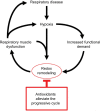Respiratory muscle dysfunction in animal models of hypoxic disease: antioxidant therapy goes from strength to strength
- PMID: 28770235
- PMCID: PMC5529115
- DOI: 10.2147/HP.S141283
Respiratory muscle dysfunction in animal models of hypoxic disease: antioxidant therapy goes from strength to strength
Abstract
The striated muscles of breathing play a critical role in respiratory homeostasis governing blood oxygenation and pH regulation. Upper airway dilator and thoracic pump muscles retain a remarkable capacity for plasticity throughout life, both in health and disease states. Hypoxia, whatever the cause, is a potent driver of respiratory muscle remodeling with evidence of adaptive and maladaptive outcomes for system performance. The pattern, duration, and intensity of hypoxia are key determinants of respiratory muscle structural-, metabolic-, and functional responses and adaptation. Age and sex also influence respiratory muscle tolerance of hypoxia. Redox stress emerges as the principal protagonist driving respiratory muscle malady in rodent models of hypoxic disease. There is a growing body of evidence demonstrating that antioxidant intervention alleviates hypoxia-induced respiratory muscle dysfunction, and that N-acetyl cysteine, approved for use in humans, is highly effective in preventing hypoxia-induced respiratory muscle weakness and fatigue. We posit that oxygen homeostasis is a key driver of respiratory muscle form and function. Hypoxic stress is likely a major contributor to respiratory muscle malaise in diseases of the lungs and respiratory control network. Animal studies provide an evidence base in strong support of the need to explore adjunctive antioxidant therapies for muscle dysfunction in human respiratory disease.
Keywords: COPD; N-acetyl-cysteine; OSA; antioxidants; diaphragm; hypoxia; respiratory muscle; upper airway.
Conflict of interest statement
Disclosure The authors report no conflicts of interest in this work.
Figures

References
-
- Goldman MD, Grassino A, Mead J, Sears TA. Mechanics of the human diaphragm during voluntary contraction: dynamics. J Appl Physiol Respir Environ Exerc Physiol. 1978;44(6):840–848. - PubMed
-
- Roussos C, Macklem PT. The respiratory muscles. N Engl J Med. 1982;307(13):786–797. - PubMed
-
- De Troyer A, Estenne M. Functional anatomy of the respiratory muscles. Clin Chest Med. 1988;9(2):175–193. - PubMed
-
- De Troyer A, Boriek AM. Mechanics of the respiratory muscles. Compr Physiol. 2011;1(3):1273–1300. - PubMed
-
- White DP. Pathogenesis of obstructive and central sleep apnea. Am J Respir Crit Care Med. 2005;172(11):1363–1370. - PubMed
Publication types
LinkOut - more resources
Full Text Sources
Other Literature Sources

